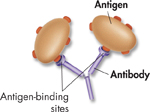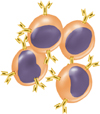How does this binding occur? As shown in Figure 35–8, an antibody is shaped like the letter Y and has two identical antigen-binding sites. The shapes of the binding sites enable an antibody to recognize a specific antigen with a complementary shape.
When an antigen binds to an antibody carried by a B cell, T cells stimulate the B cell to grow and divide rapidly. That growth and division produces many B cells of two types: plasma cells and memory B cells.

FIGURE 35–8 Antibody Structure

FIGURE 35–9 Plasma Cells

FIGURE 35–10 Memory B Cells
▸ Plasma Cells Plasma cells produce and release antibodies that are carried through the bloodstream. These antibodies recognize and bind to free-floating antigens or to antigens on the surfaces of pathogens. When antibodies bind to antigens, they act like signal flags to other parts of the immune system. Several types of cells and proteins respond to that signal by attacking and destroying invaders. Some types of antibodies can disable invaders until they are destroyed.
A healthy adult can produce about 10 billion different types of antibodies, each of which can bind to a different type of antigen! This antibody diversity enables the immune system to respond to virtually any kind of “other” that enters the body.
 In Your Notebook It is a common misconception that the immune system cannot combat pathogens it has not encountered before. In a paragraph, explain why that statement is not true.
In Your Notebook It is a common misconception that the immune system cannot combat pathogens it has not encountered before. In a paragraph, explain why that statement is not true.
▸ Memory B Cells Plasma cells die after an infection is gone. But some B cells that recognize a particular antigen remain alive. These cells, called memory B cells, react quickly if the same pathogen enters the body again. Memory B cells rapidly produce new plasma cells to battle the returning pathogen. This secondary response occurs much faster than the first response to a pathogen. Immune memory helps provide long-term immunity to certain diseases and is the reason that vaccinations work. Figure 35–11 summarizes the first and second response of humoral immunity.
Analyzing Data
Immune System “Memory”
Antibody concentration in a person's blood reveals the difference between the first and second immune response. Day 1 indicates the first exposure to Antigen A. Day 28 marks a second exposure to Antigen A and the first exposure to Antigen B.
Interpret Graphs After first exposure to an antigen, about how long does it take for antibodies to reach a detectable level?
Infer What could explain the significant increase in antibodies to A seen after Day 30?
Table of Contents
- Formulas and Equations
- Applying Formulas and Equations
- Mean, Median, and Mode
- Estimation
- Using Measurements in Calculations
- Effects of Measurement Errors
- Accuracy
- Precision
- Comparing Accuracy and Precision
- Significant Figures
- Calculating With Significant Figures
- Scientific Notation
- Calculating With Scientific Notation
- Dimensional Analysis
- Applying Dimensional Analysis





